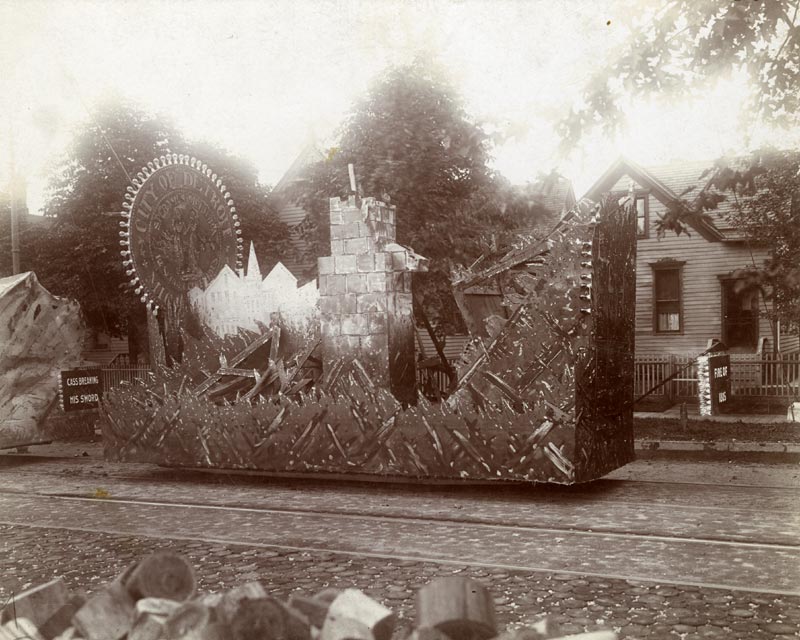Looking Backward and Forward from Detroit's Bicentennial Parade
 I’m sure we all remember the Stevie Wonder concert and the tall ships of Detroit’s tricentennial celebration in 2001, but how did Detroiters celebrate such a milestone in the days before Motown, when large sailing ships were still an everyday sight along the river? In 1901, Detroiters rang in their home’s 200th birthday with events including a re-enactment of Cadillac’s landing, speeches from politicians and historians, a time capsule intended for 2001 (in which then mayor William Maybury famously asked us future Detroiters, “How much farther have you annihilated time and space and what agencies are you employing to which we are strangers?"), and a parade of floats depicting Detroit’s history. Recently the digitization team has turned their attention to a series of thirty photos of this parade. Scenes ranging from Cadillac in the court of Louis XIV, French trading furs with Native Americans, the Battle of Bloody Run, and Louis Cass breaking his sword rather than surrendering it to the British during the War of 1812 played out atop modified street car trucks. However it’s the float representing the 1805 fire that’s not only my favorite float, but also that of one of the authors of The Bi-Centenary of the Founding of City of Detroit, 1701-1901, a book that marked the occasion. Rubble, which was would have been dramatically backlit by strands of lightbulbs, juts out at odd angles from the base of the float forming shapes that recall expressionist art, a movement which was still nearly a decade and an ocean away. Unfortunately not captured in our photo was the person dressed as the Nain Rouge whom, the Bi-Centenary book tells us, accompanied the float. In contrast to the devastation, a massive version of the city’s seal hovers overhead with its hopeful message of, “speramus meliora; resurget cineribus,” the city’s motto, meaning, “we hope for better things; it will rise from the ashes.”
I’m sure we all remember the Stevie Wonder concert and the tall ships of Detroit’s tricentennial celebration in 2001, but how did Detroiters celebrate such a milestone in the days before Motown, when large sailing ships were still an everyday sight along the river? In 1901, Detroiters rang in their home’s 200th birthday with events including a re-enactment of Cadillac’s landing, speeches from politicians and historians, a time capsule intended for 2001 (in which then mayor William Maybury famously asked us future Detroiters, “How much farther have you annihilated time and space and what agencies are you employing to which we are strangers?"), and a parade of floats depicting Detroit’s history. Recently the digitization team has turned their attention to a series of thirty photos of this parade. Scenes ranging from Cadillac in the court of Louis XIV, French trading furs with Native Americans, the Battle of Bloody Run, and Louis Cass breaking his sword rather than surrendering it to the British during the War of 1812 played out atop modified street car trucks. However it’s the float representing the 1805 fire that’s not only my favorite float, but also that of one of the authors of The Bi-Centenary of the Founding of City of Detroit, 1701-1901, a book that marked the occasion. Rubble, which was would have been dramatically backlit by strands of lightbulbs, juts out at odd angles from the base of the float forming shapes that recall expressionist art, a movement which was still nearly a decade and an ocean away. Unfortunately not captured in our photo was the person dressed as the Nain Rouge whom, the Bi-Centenary book tells us, accompanied the float. In contrast to the devastation, a massive version of the city’s seal hovers overhead with its hopeful message of, “speramus meliora; resurget cineribus,” the city’s motto, meaning, “we hope for better things; it will rise from the ashes.”  And this hope was obviously strong, as the final float of this series depicted not a scene from Detroit’s past, but instead its future. Amid classical columns and women representing things like science, industry, and commerce is a mural depicting a surprisingly familiar looking suspension bridge over the busy Detroit River. Considering the long debated Detroit-Windsor crossing wasn’t finalized until construction began on the Ambassador Bridge 26 years later, we can overlook that they’ve placed it in the heart of the skyscraper-filled downtown. I don’t recall any similar predictions of Detroit at 400 during our celebrations in 2001. If you remember any examples, we’d love to hear from you.
And this hope was obviously strong, as the final float of this series depicted not a scene from Detroit’s past, but instead its future. Amid classical columns and women representing things like science, industry, and commerce is a mural depicting a surprisingly familiar looking suspension bridge over the busy Detroit River. Considering the long debated Detroit-Windsor crossing wasn’t finalized until construction began on the Ambassador Bridge 26 years later, we can overlook that they’ve placed it in the heart of the skyscraper-filled downtown. I don’t recall any similar predictions of Detroit at 400 during our celebrations in 2001. If you remember any examples, we’d love to hear from you.

